List 5
1.Achillea millefolium
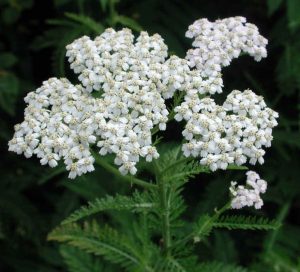
(http://www.all-creatures.org/picb/wfshl-yarrow.html)
Common name: yarrow
family name: Asteraceae
USDA Hardiness Zone: 3-9
Mature height and spread:
height: 2-3feet
spread: 2-3feet
Form: spreading, upright to mat-forming
Water use: medium
Soil requirements:dry to medium, well-drained sandy loams in full sun
Flower/Cone/Fruit description: These species plants are noted for producing deeply-dissected, fern-like, aromatic, medium green foliage and tiny, long-lasting, white flowers that appear in dense, flattened, compound corymbs (to 2-4” across) throughout the summer on stems typically rising 2-3’ tall. Foliage has a strong, somewhat spicy aroma that persists when used in dried arrangements. Species plants are uncommonly sold in commerce, however. It is the cultivars and hybrids of common yarrow, most of which have stronger stems, more upright habits and larger flowers, that have become popular flowering plants for ornamental gardens. Cultivars also extend the range of flower colors to include pinks, reds, creams, yellows and bicolor pastels.
Limitations:Stem rot, powdery mildew and rust are occasional disease problems. Plant stems are weak and lodge easily. If grown ornamentally, plants can develop into a tangled mass of stems and foliage by mid to late summer if not cut back. Strong summer rain storms with high winds can easily flatten exposed plantings. May spread somewhat aggressively.
suitable uses:Cottage gardens, wild gardens, meadows, prairies and naturalized areas. Good fresh cut or dried flower.
2.Allium cernuum
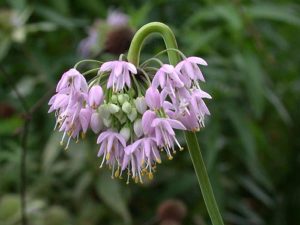
(https://www.google.ca/url?sa=i&rct=j&q=&esrc=s&source=images&cd=&cad=rja&uact=8&ved=0ahUKEwj4lM6StcvNAhUG-GMKHUj5DtMQjRwIBw&url=https%3A%2F%2Fwww.prairiemoon.com%2Fseeds%2Fwildflowers-forbs%2Fallium-cernuum-nodding-onion.html&psig=AFQjCNE9IqwmwbbUEVFWEX5Q10Y5HOWYew&ust=1467227132753477)
Common name: nodding onion
family name: Amaryllidaceae
USDA Hardiness Zone: 4-8
Mature height and spread:
height: 1-1.5feet
spread: 0.25-0.5feet
Form: open woods
Water use: medium
Soil requirements:dry to medium, well-drained sandy loams in full sun
Flower/Cone/Fruit description: Features clumps of flat, narrow, grass-like leaves (to 12” tall) and tiny bell-shaped, pink to lilac pink (occasionally white) flowers which appear in loose, nodding clusters (umbels) atop erect, leafless scapes rising slightly above the foliage. Wild nodding onion is distinguished from most other native alliums by the fact that its scapes crook sharply downward at the top just below the flower so that the flower umbel nods (hence the common name). Blooms in summer. All parts of this plant have an oniony smell when cut or bruised.
Limitations: Foliage dies back in late summer.
suitable uses:Rock gardens, border fronts, cottage gardens or naturalized areas.
3.Delosperma cooperi
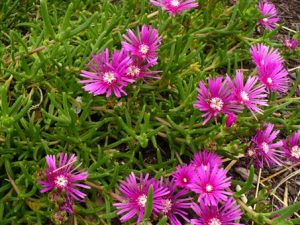
(http://www.howsweetgarden.com/perennial/delosperma-cooperi)
Common name: hardy ice-plant
family name: Aizoaceae
USDA Hardiness Zone: 6-10
Mature height and spread:
height: 0.25-0.5feet
spread: 1-2feet
Form: vigorous, succulent, spreading, evergreen ground cover
Water use: medium
Soil requirements:dry to medium, well-drained sandy loams in full sun
Flower/Cone/Fruit description: This is a succulent mat-forming plant that typically grows to 3” tall and spreads quickly to 24” or more. Daisy-like, bright red-purple flowers (to 2” diameter) cover the plant with bloom from June to September. The neon-like intensity of the flower color and length of bloom greatly enhance the ornamental interest of these plants. Succulent, fleshy, cylindrical, medium green leaves.
Limitations: Aphids and mealybugs may visit. Winter hardiness is a problem in St. Louis.
suitable uses:Sunny but sheltered areas of desert gardens, rock gardens, border fronts or slopes. Ground cover or edger.
4.Lobularia maritima
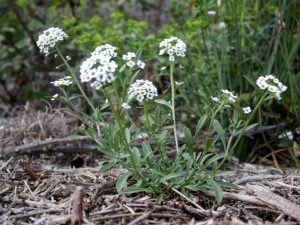
(http://www.imagejuicy.com/images/plants/l/lobularia/1/)
Common name: hardy ice-plant
family name: Aizoaceae
USDA Hardiness Zone: 5-9
Mature height and spread:
height: 0.25-0.75feet
spread: 0.5-1feet
Form: mat-forming
Water use: medium
Soil requirements:dry to medium, well-drained sandy loams in full sun
Flower/Cone/Fruit description: well-branched stems clad with linear, lance-shaped, gray-green leaves (to 1” long). Plants typically grow 3-9” tall to 12” wide. Dense clusters of sweetly fragrant, tiny, white 4-petaled flowers cover the foliage mounds from spring to early summer. Flowering is often so profuse as to totally hide the foliage.
Limitations: Damping off is an occasional problem with seedlings.
suitable uses:Mass in border fronts or rock gardens. Underplanting. Edging and bedding. Mixed containers.
List 6
1.Asplenium scolopendrium
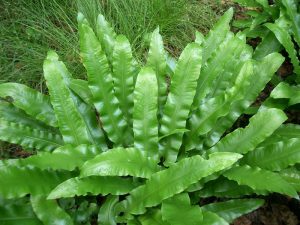
(http://fallingwatergardens.com/plants/?product=asplenium-scolopendrium)
Common name: hart’s tongue fern
family name: Aspleniaceae
USDA Hardiness Zone: 5-9
Mature height and spread:
height: 1-1.5feet
spread: 1-1.5feet
Form: rhizomatous, evergreen fern
Water use: medium
Soil requirements:dry to medium, well-drained sandy loams in full sun
Flower/Cone/Fruit description: erect-arching clump of tongue-shaped, leathery, bright green fronds (12-18” long) which may have wavy margins. Sori are arranged on the frond undersides in rows that purportedly resemble the many legs of a centipede
Limitations: Root rot can be a problem in poorly drained soils.
suitable uses:Woodland gardens and shade gardens. Good selection for shady areas of limestone rock gardens.
2.Begonia grandis
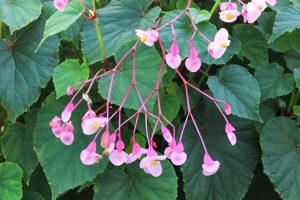
(http://www.plantdelights.com/Begonia-grandis-Herons-Pirouette-for-sale/Buy-Herons-Pirouette-Hardy-Begonia/)
Common name: hardy begonia
family name: Begoniaceae
USDA Hardiness Zone: 6-9
Mature height and spread:
height: 1.5-2feet
spread: 1.5-2feet
Form: clump-forming
Water use: medium
Soil requirements:dry to medium, well-drained sandy loams in full sun
Flower/Cone/Fruit description: It is a monoecious, tuberous-rooted, clump-forming perennial that typically forms a bushy mound of foliage to 2’ tall on branching stems. Large, obliquely ovate leaves (to 4” long) with cordate bases are medium to olive green above and reddish green with red veining beneath. Male and female pale pink flowers (to 1” across) bloom in pendent clusters (dichotomous cymes) from July to early fall.
Limitations: None
suitable uses:Good late summer flowering shade plant which mixes well with hostas and ferns in the shade garden, woodland garden or shaded border.
3.Deschampsia cespitosa
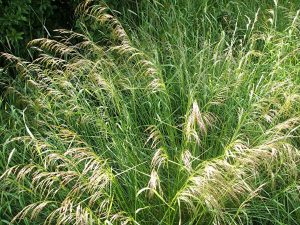
(http://www.naturespot.org.uk/species/tufted-hair-grass-0)
Common name: tufted hair grass
family name: Poaceae
USDA Hardiness Zone: 4-9
Mature height and spread:
height: 2-3feet
spread: 1-2feet
Form: low, dense tussock
Water use: medium
Soil requirements:dry to medium, well-drained sandy loams in full sun
Flower/Cone/Fruit description: It typically forms a low, dense tussock (to 16″ tall) of very thin (1/5″ wide), arching, flat to inrolled, dark green grass blades (to 2′ long). Numerous flower stems rise in summer from the foliage mound to a height of 3′ bearing wide, airy panicles (to 20″ long) of tiny, variably-colored flowers (tones of gold, silver, purple and green) which form a cloud over the foliage that is particularly attractive when backlit. Flower panicles turn yellowish-tan after bloom as the seed ripens and may remain attractive through much of the winter.
Limitations: None
suitable uses:Excellent massed in woodland gardens or naturalized areas where the ethereal summer bloom produces a delicate cloud of subtle colors hovering above the foliage. Also effective as a specimen or in groups in shaded areas of borders, large rock gardens or moist areas along ponds or streams. Mixes well with shade loving perennials such as ferns and hostas.
4.Festuca glauca
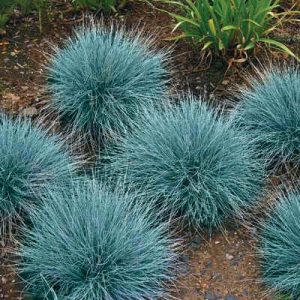
(http://www.rarexoticseeds.com/en/festuca-ovina-glauca-seeds-blue-fescue-grass-seeds.html)
Common name: sheep fescue
family name: Poaceae
USDA Hardiness Zone: 4-8
Mature height and spread:
height: 0.75-1feet
spread: 1-1.5feet
Form: short-lived, low-growing, semi-evergreen, clump-forming ornamental grass
Water use: medium
Soil requirements:dry to medium, well-drained sandy loams in full sun
Flower/Cone/Fruit description: glaucous, finely-textured, blue-gray foliage. Foliage forms a dome-shaped, porcupine-like tuft of erect to arching, needle-like blades radiating upward and outward to a height of 6-8″ (inflorescences typically bring total clump height to 10-14″). Light green flowers with a purple tinge appear in terminal panicles atop stems rising above the foliage in late spring to early summer, but inflorescences are not very showy. Flowers give way to buffy seed heads which some gardeners find attractive but others find detractive to both the symmetry of the plant and the foliage color.
Limitations: Plants are short lived and require frequent division. Plant foliage may decline considerably in hot, humid summers.
suitable uses:Excellent as ground cover, border front or rock garden accent or edging plant.